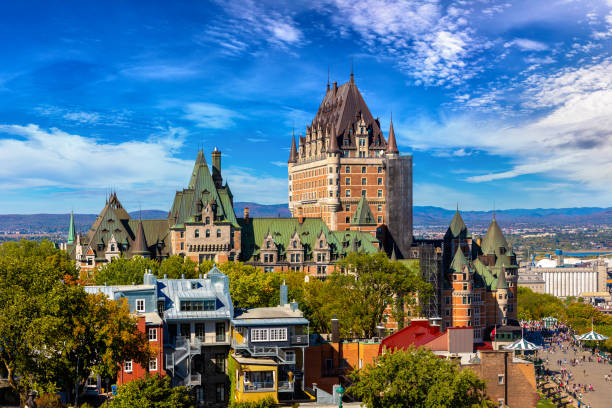French-speaking Quebec City is strategically located atop steep cliffs that overlook the St. Lawrence River. It’s in fact, the only walled city in North America and holds the honor of being a UNESCO World Heritage Site.
Founded in 1608 as a fur trading colony, Quebec City quickly became an administrative center and is today the capital of Quebec Province.
The Upper Town, which is also known as Haute-Village, was originally developed for its military advantage and features the defensive Citadel as well as some of the city’s most breathtakingly beautiful and iconic landmarks, like the Chateau Frontenac and the City Fortifications.
The Lower Town, which is also called Basse-Ville, on the other hand, is where the original settlement was built and is known for its pleasant narrow streets and historic stone buildings.
From there, you can access the Quebec-Levis Feery at Vieux Port. In that part of town, you’ll also find many tourist attractions such as the Musee de la Civilization and the picturesque Quartier Petit-Champlain Neighborhood, where there are plenty of things to do and sights to see. The upper and lower districts are connected by winding streets, steep flights of stairs, and the Funiculaire – a functional railway that operates with service between the two historic neighborhoods.
Intensely proud and protective of its French-Canadian identity and language, Quebec City serves as the heart and soul of the province that shares its name. Many of its museums, restaurants and tourist attractions highlight this rich cultural heritage – as does its many festivals and annual events.
With so many thrilling and best things to do in Quebec City – not to mention all of the history and nature you can explore while you’re there – the provincial capital of Quebec is a must-visit location when you’re exploring all that Canada has to offer.
Fortifications of Quebec National Historic Site

The only city walls still erected in North America outside of Mexico are the Fortifications of Quebec which are now a protected National Historic Site. Built in the seventeenth century, these sturdy ramparts, gates, and towers played a crucial role in the defense of the colony and withstood several attacks by the French and Americans.
Revitalized and expanded at numerous times over the centuries that they’ve been standing, the walls now stretch nearly three miles in length and wind around the perimeter of Old Quebec. Wander along its ramparts and enjoy unparalleled views of the city and its many landmarks.
Hey, not to get too off-topic, but if you’re diggin’ this video so far, make sure you give it a like and subscribe to Viewcation if you haven’t already.
And don’t go anywhere just yet. Keep watching to see what we think is the top sight worth seeing in Quebec City.
La Citadelle de Quebec
Located atop Cap Diamant, this citadel contains the oldest military building in Canada and forms part of the city’s fortifications. It’s also an active military installation and the secondary official residence of both the Canadian monarch as well as the governor-general of Canada.
La Citadelle is the headquarters of the 22nd Canadian Regiment, which was formed at the beginning of the First World War and boasts a distinguished record including action at the Battle of the Somme and much later in its history, in the Korean War.
If you visit the site in the summer, you can watch the Changing of the Guard ceremony each morning. Afterward, you can pay a visit to the military museum which is open year-round and is located in the mid-18th century powder magazine in the southern corner of the citadel.
Plains of Abraham (Champs de Bataille)
Directly west of the Citadel and outside of the old city’s walls, stretches the green expanse known as the Plains of Abraham. In 1759, the British, led by General Wolfe, victoriously fought off the French under Commander Louis-Joseph de Montcalm. Exhibits here detail the turbulent history of how Quebec City at first resisted and then lost to the British.
The park also hosts the two Martello towers that were later additions to the cities fortifications. In the late 1930s construction began on the Joan of Arc Garden which was designed by Louis Perron. From spring until fall, you can come see a phenomenal flower display here.
Families with young children will find interactive exhibits at the museum that encourage guests to actively engage with history. Kids will especially appreciate taking part in the family treasure hunt which involves exploring and discovering historical finds around the park.
Musee National des Beaux-Arts de Quebec
This museum, which can be found in Battlefields Park, is host to one of the largest art collections in Canada. While the museum’s primary focus is highlighting artworks produced within the province, it’s also home to over 40,000 paintings, prints, and sculptors by renowned actors from other regions around Canada as well as from the rest of the world.
Opened in 1933, the Musee National des Beaux-Arts de Quebec’s massive collection now sprawls over four buildings with each pavilion being connected by a series of underground tunnels. Especially noteworthy is its sublime exhibit on Inuit Art which features works from celebrated artists such as Jean-Paul Lemieux and Fernand Leduc.
Musee de la Civilisation
This museum is a three-part institution that explores the multifaceted history of humanity as well as the establishment of French America. The main museum is located in Basse-Ville near the old Port. Built under the direction of the illustrious architect Moshe Safdie, the central museum is of great interest to architecture fans. The permanent collection features works from civilizations from all over the globe.
The Musee de I’Amerique Francophone or for English speakers, the Museum of Franch America, can be found in the historic Seminaire de Quebec in Upper Town. As the name implies, the museum explores the various chapters of history of the French in North America.
Place Royale is the third component of the Musee de la civilisation, and we think that it’s one of the most historically significant attractions in Quebec.
Place Royale
Place Royale actually stands on the site of Quebec’s actual foundation. On this very spot in 1608, Samuel de Champlain built a fur trading post that quickly grew into the capital of the French Canadian province. Place Royale is, in fact, the largest still-standing ensemble of 17th and 18th-century buildings in North America.
The gorgeous stone church Notre-Dame des Victoires is built in the midst of a cobbled square alongside Maison Chevalier of the Musee de la Civilization which we’ll discuss in more detail in just a moment. The adjacent Batterie Royale was constructed in 1691 and faces out over the river and is encircled by stalwart walls and palisades.
Terrasse Dufferin
One of the most popular places to visit in the city is Terrasse Dufferin, which offers breathtaking views out over Old Quebec and the Saint Lawrence River. Sitting high atop a cliff, the long boardwalk wraps around Chateau Frontenac, the historic hotel that dominates the city’s skyline. Chateau Frontenac can actually be seen from miles away and is especially impressive to see at night.
Terrasse Dufferin was the original site of Fort St. Louis, the governor’s place of residence back during Quebec’s colonial era. Tourists can check out the ruins underneath the promenade. It’s also historically important for hosting the Quebec Conference in August 1943, where the Allied Powers laid preparations for the D-Day landings in Normandy on June 6th, 1944.
Built in 1879, Terrasse Dufferin also has an appealing ambiance as street performers and artists often set up shop on the terrace.
Cathedral-Basilica of Notre-Dame de Quebec
Even though it’s been burnt down and destroyed plenty of times throughout its long, storied history, the Cathedral-Basilica of Notre-Dame de Quebec is the oldest Church in Canada as it has been standing in its various incarnations in the same spot since 1647.
Located in the center of Old Quebec, the cathedral features a somewhat austere exterior appearance with its large grey facade topped by two towering towers. Inside, the illuminated cathedral boasts a collection of ornate shimmering treasures, colorful stained glass, and historic religious works of art.
Montmorency Falls Park
A quick 15-minute drive to the northeast of Quebec City will bring you to one of the region’s most outstanding natural sights, the impressive Montmorency Falls. Situated in a beautiful scenic park that shares its name, the waterfall looms a lofty 275 feet above ground which actually is much taller than the renowned Niagara Falls.
While the waterfall is an excellent subject for photographers to get lost in, the park itself is also well worth your time exploring. Aside from a suspension bridge and cable car that offers up a commanding view of the falls, it is also an excellent spot if you enjoy things like hiking, playgrounds, and zip-lines.
Old Quebec
Last but not least we have the historic heart of the city. Old Quebec is the go-to destination in Quebec City if you’re looking for attractions, beautiful historic buildings, and charming streets practically begging you to go for a leisurely stroll. Old Quebec is comprised of both Upper Town and Lower Town with the old port and Battlefields Parks lying on both sides.
Within its battlemented walls are not just numerous museums and monuments, but also the historic Place Royale, the first site settled in the city. This historic borough also hosts countless centuries-old buildings and must-see sights like its citadel and cathedral.
Old Quebec is the highlight of most visitors’ trips. It has an inviting atmosphere with its numerous shops and restaurants. If there is one place in Quebec City that you absolutely must see, it would have to be Old Quebec.
While there you can take the funicular train for easy transportation up Cap Diamant connecting Upper Town from the narrow Petit-Champlain road at the foot of the cape to the top. There you will find a marvelous view of the city.
So, what are you waiting for? Have you booked your flight yet? Quebec City has so much to explore and boasts such a rich history – it would be virtually reckless not to visit at least once in your life. Plus, the cuisine there is out of this world. Seriously, if you want to try one of the finest restaurants in the world, you’ve just got to check out Restaurant Taniere near the Musee de la Civilisation. We promise you that you won’t be disappointed.
Anyway, we’re just about out of time, but if we forget to mention one of your favorite sights or attractions in Quebec City, let us know in the comments section below.
And one last thing before you go. If you enjoyed watching this video, do us a favor and show us a little bit of support by giving this video a like and by subscribing to Viewcation. Tap the bell to turn no notifications. That way you can keep up with all of our latest and upcoming videos without missing a beat.
And as always, thanks for watching. We’re looking forward to seeing you next time when we bring you another ViewTastic video.
